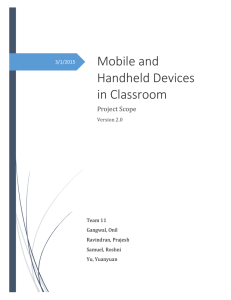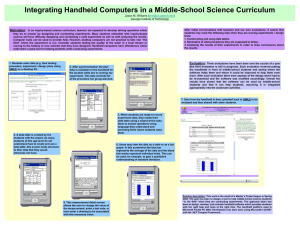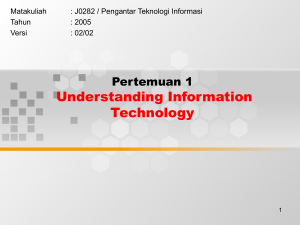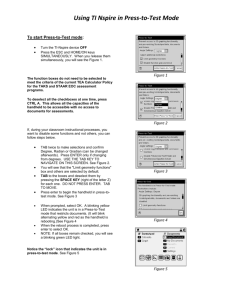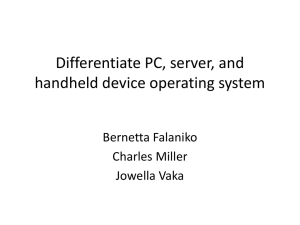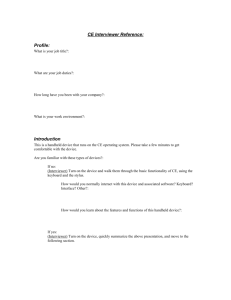影響消費者採用手持式近距離無線通訊 裝置因素之研究 ( 報告者:呂冠璁
advertisement
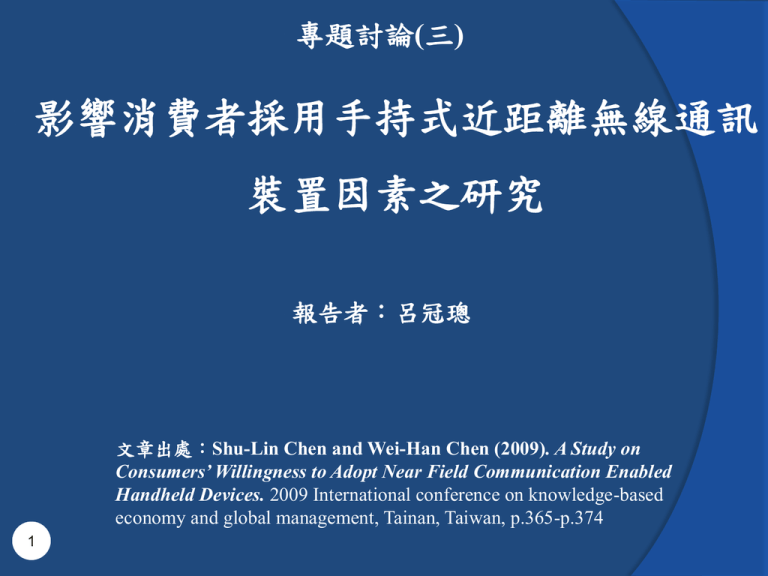
專題討論(三) 影響消費者採用手持式近距離無線通訊 裝置因素之研究 報告者:呂冠璁 文章出處:Shu-Lin Chen and Wei-Han Chen (2009). A Study on Consumers’ Willingness to Adopt Near Field Communication Enabled Handheld Devices. 2009 International conference on knowledge-based economy and global management, Tainan, Taiwan, p.365-p.374 1 Agenda 1. 2. 3. 4. 5. 2 Introduction Literature Review Research Methodology Statistical Analysis Conclusions and Suggestions Introduction Background and Motivation Research Purpose Research Scope Research Process 3 Background and Motivation 4 Ubiquitous Computing = U UNS = Ubiquitous Network Society (2007~2011) U-Japan & U-Korea U-Taiwan project is about the “INNOVATE TAIWAN” U-Taiwan (2008) Ubiquitous Network Society (UNS) 5 Network Convergence Human Computer linked Perception environment Innovative services Security trust Any people Any time Any place Background and Motivation 3C products (Consumer, Computer and Communication) smaller lightweight portable attractiveness wireless communication 6 Wireless Communication Technology 7 UWB IrDA Bluetooth Zigbee NFC Distance < 10m < 1m 10m 3~5m < 20cm Time ~1s ~1s ~ 6s ~0.5s < 0.1s Security High High High Medium Very high Price High High Medium Low Very low Research Purposes Payments News (2009) The NFC chip will combine • Mobile phone • PDA • Digital cameras • Computers • Watches • All kinds of consumer electronics products 8 Research Purposes 9 To explore what will be the consumers’ attitudes and behavioral intentions for the demand of NFC-enabled handhelds devices. To discuss and analyze the factors that affect consumers to adopt NFC-enabled handheld devices. To investigate the consumers’ intention and willingness adopt the NFC-enabled handheld devices. Literature Review Near Field Communication (NFC) Technology Acceptance Model (TAM) Perceived Convenience (PC) 10 Near Field Communication (NFC) 11 NFC technology is an extension of Raid Frequency Identification (RFID) technology. NFC technology has the potential to bring mobile devices and physical objects together (Falke et al., 2007). NFC Feature (NFC forum white paper, 2007) 12 short range wireless connectivity technology (also known as ISO 18092) simple and safe communication between electronic devices within 4cm of one another transfers data at up to 424 Kbits/ per second inherently secure NFC Applications Contactless payments Access to buildings Service discovery Discount coupons Touch-and-go transportation Mobile advertising NFC Mark 13 NFC Applications Get on the bus by waving your NFC phone Pay for goods with a tap of your NFC phone Set up your wireless home office with a touch 14 Use your NFC phone as an event ticket NFC Consumer Device Get information by touching smart posters Print from your camera by holding it close to the printer Share business cards with a touch Technology Acceptance Model (TAM) Perceived Usefulness Attitude toward using External Variable Perceived Ease of use Source : TAM Structure (Davis et al. ,1989) 15 Behavioral intention to use Actual System use Technology Acceptance Model (TAM) 16 Explains and predicts the users’ acceptance of information technology or IT-related applications (Davis, 1989 & Davis et al., 1989) TAM considers that antecedent, external variables, can directly affect PU and PEOU (Davis, 1989 ) Technology Acceptance Model (TAM) Davis(1986) defined Perceived usefulness The degree to which an individual believes that using a particular system would enhance his or her job performance. Perceived ease of use The degree to which an individual believes that using a particular system would be free of physical and mental effort. 17 Perceived Convenience (PC) 18 Yoon and Kim (2007) pointed out “the construct of convenience has not been defined clearly and operationalized in the literature.” Convenience denoted the time and effort consumers used in purchasing a product rather than a characteristic or attribute of a product (Brown, 1990). Perceived Convenience (PC) Brown (1990) The concept of convenience was proposed to have five dimensions. Dimensions Time Product may be provided at a time that is more convenient for the customer. Place Product may be provided in a place that is more convenient for the customer. Execution The most obvious convenience is simply having someone provide the product for the consumer. Acquisition Firms may make it easier for the customer, financially and otherwise, to purchase their products. Use 19 Definition Product may be made more convenient for the customer to use. Perceived Convenience (PC) Yoon and Kim (2007) excluded the acquisition and use dimensions from their research. Dimensions 20 Definition Time The degree of perception held by some-one that he/she can use wireless LAN to accomplish their job at a time that is more convenient for them. Place The degree of perception held by some-one that he/she can use wireless LAN to accomplish their job in a place that is more convenient for them. Execution The degree of perception held by someone that he/she finds the wireless LAN convenient in the process of accomplishing his or her work. Research Methodology Research Framework Research Hypothesis Research Design 21 Research Framework Perceived Usefulness H8 H3 H1 Perceived Convenience Attitude Toward Adopting H7 H6 H2 Perceived Ease of Use 22 H4 H5 Behavioral Intention Research Hypotheses 23 H1 Perceived ease of use (PEOU) positively influences perceived usefulness (PU) to adopt the NFC-enabled handheld devices. H2 Perceived ease of use (PEOU) positively influences consumers’ attitude toward adopting (ATA) the NFC-enabled handheld devices. H3 Perceived usefulness (PU) positively influences consumers’ attitude toward adopting (ATA) the NFC-enabled handheld devices. H4 Perceived usefulness (PU) positively influences behavioral intention (BI) to adopt the NFC-enabled handheld devices. H5 Consumers’ attitude toward adopting (ATA) positively influences consumers’ behavioral intention (BI) to adopt the NFC-enabled handheld devices. H6 Perceived convenience (PC) positively influences perceived ease of use (PEOU). H7 Perceived convenience (PC) positively influences consumers’ attitude toward adopting (ATA) the NFC-enabled handheld devices. H8 Perceived convenience (PC) positively influences perceived usefulness (PU). Operational Definition Perceived Ease of Use ○ the degree to which a person believes that using the NFC-enabled handheld would be free of effort. 24 Items Measurement 1 Learning to operate NFC-enabled handheld device will be easy for me. 2 I would find that it is easy to get NFC-enabled handheld to do what I want it to do. 3 My interaction with NFC-enabled handheld would be clear and understandable. 4 I think that NFC-enabled handheld device is easy to use. Operational Definition Perceived Usefulness ○ the degree to which a person believes that using the NFC- enabled handheld devices would help the users complete his/her works in any place. Items 1 2 3 4 5 25 Measurement I think that NFC-enabled handheld device provides very useful service and information to me. I think that NFC-enabled handheld device is helpful to enhance effectiveness of my life in general. I think that NFC-enabled handheld device is more convenience of my life. I think that NFC-enabled handheld device make my life much easier. I think that NFC-enabled handheld device is helpful to me. Operational Definition Perceived Convenience ○ the degree to which a person can use the NFC-enabled handheld to accomplish his/her conveniently. Items 1 2 3 4 5 26 6 Measurement Using the NFC-enabled handheld device helps me to accomplish my job at any time. Using the NFC-enabled handheld device is able to make me deal with things at any time. I find that the NFC-enabled handheld device is convenient for my work. Using the NFC-enabled handheld device gives me convenience in performing my work. It doesn’t spend many efforts and money to pay the service of NFCenabled handheld device. The NFC-enabled handheld device can complete the transaction quickly. Operational Definition Adopt toward adopting ○ a person considers to adopt the NFC-enabled handheld devices attitude. Items 27 1 Measurement Adopting the NFC-enabled handheld device would be beneficial to me. 2 The NFC-enabled handheld device is a good idea. 3 Adopting the NFC-enabled handheld device is a wise idea. Operational Definition Behavioral Intention ○ the possibility of a person who is willing to adopt the NFC-enabled handheld devices. Items 28 Measurement 1 I intend to use the NFC-enabled handheld device in the future. 2 I intend to continue using the NFC-enabled handheld device. 3 I will recommend others to use the NFC-enabled handheld device in the future. Research Design Survey Design A. Seven point Likert-type scale B. Demographic information design 29 Sample and Data Collection Sample • Beyond the age 18 • No matter he/she uses the NFC-enabled handheld devices or not, only if he/she has been used contactless cards Data Collection Through Internet The web site of “my 3q.com” (http://www.my3q.com/) 30 Data Analysis Methodology 31 SPSS 12.0 and AMOS 7.0 Reliability Confirmatory factor analysis (CFA) Second-order CFA Structural Equation Modeling (SEM) Maximum Likelihood Estimation (MLE) to estimate the parameters. Overall Fit Assessment Absolute Fit Index CMIN / df GFI AGFI RMSEA Incremental Fit Index Parsimonious Fit Index 32 Recommended value Literature The smaller the better 1< / df <3 ≧0.90 ≧0.90(Good) ≧0.80(OK) Bentler and Bonett (1980) Jöreskog and Sörbom, (1981) < 0.01 0.01< RMSEA<0.05 0.05< RMSEA<0.08 0.08< RMSEA<0.1 > 0.1 NFI ≧0.90 CFI RFI IFI PGFI PNFI ≧0.90 ≧0.90 ≧0.90 ≧0.50 ≧0.50 PCFI ≧0.50 Excellent Very good Good Middle Bad Steiger (1990) Brown and Cudeck (1993) Bentler and Bonett (1980) Bentler (1990) Bollen (1986) Bollen (1989) James, Mulaik and Brett (1982), Mulaik et al. (1989) Statistical Analysis Characteristic Gender Age Education Job 33 Male Female 18~22 23~27 28~32 Over 33 Senior high school Bachelor’s degree Over Master’s degree Student Public service SOHO Service Financial Information professional Others Frequency Proportion (%) 186 114 119 151 26 4 8 194 98 229 7 4 29 1 15 8 7 62% 38% 39.7% 50.3% 8.7% 1.3% 2.7% 64.6% 32.7% 76.4% 2.3% 1.3% 9.7% 0.3% 5.0% 2.7% 2.3% Characteristic Frequency Proportion (%) Yes 204 68% No 96 32% Yes 208 69.3% No 92 30.7% Have you ever been used the NFC-enabled handheld device? Yes 160 53.3% No 140 46.7% Will you intend to use the NFC-enabled handheld device in the future Yes 266 88.7% No 34 11.3% Do you know the NFC? Do you know the NFC -enabled handheld device? 34 Reliability Analysis Factors PEOU PU PC ATA 35 BI PEOU1 PEOU2 PEOU3 PEOU4 PU1 PU2 PU3 PU4 PU5 PC1 PC2 PC3 PC4 PC5 PC6 ATA1 ATA2 ATA3 BI1 BI2 BI3 Item-to-Total Correlation Alpha if Deleted 0.835 0.876 0.827 0.881 0.770 0.876 0.896 0.839 0.758 0.796 0.824 0.833 0.829 0.710 0.779 0.802 0.822 0.795 0.848 0.898 0.831 0.927 0.912 0.928 0.911 0.931 0.911 0.907 0.918 0.933 0.915 0.911 0.910 0.911 0.928 0.917 0.863 0.846 0.871 0.909 0.866 0.923 Cronbach Alpha 0.938 0.935 0.928 0.903 0.931 First-order CFA of PC 36 Second-order CFA of PC 37 The second-order result of perceived convenience CFA model Recommended value CMIN The smaller the better 10.542 Pass / df 1< / df <3 1.757 Pass GFI ≧0.90 0.989 Pass AGFI ≧0.80 0.961 Pass RMSEA <0.08(OK),<0.05(Good) 0.05 Pass NFI ≧0.90 0.993 Pass CFI ≧0.90 0.997 Pass RFI ≧0.90 0.982 Pass IFI ≧0.90 0.997 Pass PGFI ≧0.50 0.283 Pass PNFI ≧0.50 0.397 Pass PCFI ≧0.50 0.399 Pass Absolute Fit Index Incremental Fit Index Parsimonious Fit Index 38 Measurement Outcome model Overall Fit Assessment The results of the hypothesized model fit statistic Recommended value Measurement model Outcome CMIN The smaller the better 476.378 Pass / df / df <3 2.676 Pass GFI >0.90 0.868 Not pass AGFI >0.80 0.829 Pass RMSEA <0.08(OK),<0.05(Good) 0.75 Pass NFI >0.90 0.929 Pass CFI >0.90 0.954 Pass RFI >0.90 0.917 Pass IFI >0.90 0.955 Pass PGFI >0.50 0.669 Pass PNFI >0.50 0.788 Pass PCFI >0.50 0.809 Pass Overall Fit Assessment Absolute Fit Index Incremental Fit Index Parsimonious Fit Index 39 The model of the modification 40 Model Revised item CMIN DF CMIN/DF P-value GFI Original ---- 476.378 178 2.676 0.000 0.868 0.829 0.075 Revised 1 PU5 438.047 159 2.755 0.000 0.873 0.833 0.077 Revised 2 PU3 381.625 141 2.707 0.000 0.883 0.843 0.076 Revised 3 PEOU4 314.697 124 2.538 0.000 0.898 0.859 0.072 Revised 4 ATA2 269.415 108 2.495 0.000 0.908 0.869 0.071 AGFI RMSEA The measurement and structural components of revised hypothesized models 41 The fit indices for the measurement model CMIN The smaller the better Measurement model 269.415 / df 1< / df <3 2.495 Pass GFI ≧0.90 0.908 Pass AGFI ≧0.80 0.869 Pass RMSEA <0.08(OK),<0.05(Good) 0.071 Pass NFI ≧0.90 0.946 Pass CFI ≧0.90 0.967 Pass RFI ≧0.90 0.932 Pass IFI ≧0.90 0.967 Pass PGFI ≧0.50 0.641 Pass PNFI ≧0.50 0.751 Pass PCFI ≧0.50 0.768 Pass Overall Fit Assessment Absolute Fit Index Incremental Fit Index Parsimonio us Fit Index 42 Recommended value Outcome Pass Factor loadings of parameter estimates 43 Path Estimate Standard Error Critical Ration PEOU PC 0.895 0.066 13.549 *** Yes PU PC 0.132 0.066 1.986 0.047 Yes PU PEOU 0.804 0.059 13.662 *** Yes ATA PC 0.742 0.083 8.976 *** Yes ATA PU 0.340 0.132 2.578 0.010 Yes ATA PEOU -0.264 0.127 -2.081 0.037 No BI PU -0.043 0.059 -0.735 0.462 No BI ATA 1.112 0.084 13.169 *** Yes Note: *** p < 0.001 P-value Support Path diagram fit research model Perceived Usefulness H8 0.11 (0.047) Perceived Convenience H1 0.83 (0.000) H7 0.75 (0.000) 0.74 (0.000) Perceived Ease of Use -0.04 (0.462) 0.40 (0.010) Attitude Toward Adopting -0.32 (0.037) H H6 44 H3 H4 2 H5 0.92 (0.000) Behavioral Intention The standardized total effects PC PEOU PU ATA BI PEOU 0.740 (0.740+0) --- --- --- --- PU 0.729 (0.113+0.616) 0.833 (0.833+0) --- --- --- ATA 0.806 0.011 (0.753+0.053) (-0.324+0.335) 0.402 (0.402+0) --- --- BI 45 0.712 (0+0.712) -0.025 (0+-0.025) 0.328 0.921 0 (-0.042+0.370) (0.921+0) (0+0) Note: Total effects = Direct effects + Indirect effects Results of path analysis Path 46 Estimate Standard Error Critical Ration P-value Outcome H1 PU PEOU 0.804 0.059 13.662 *** Supported H2 ATA PEOU -0.264 0.127 -2.081 0.037 Supported H3 ATA PU 0.340 0.132 2.578 0.010 Supported H4 BI PU -0.043 0.059 -0.735 0.462 Not Supported H5 BI ATA 1.112 0.084 13.169 *** Supported H6 PEOU PC 0.895 0.066 13.549 *** Supported H7 ATA PC 0.742 0.083 8.976 *** Supported H8 PU PC 0.132 0.066 1.986 0.047 Supported Note: *** p < 0.001 Conclusions The PEOU impacts on the PU. PEOU seems to be highly correlated to PU. An easily using product will attract people to use it. The PU impacts on the ATA. PU is positively impact on ATA. Consumers think the NFC product may save time, money and improve the efficiency of NFC-enabled handheld devices. 47 Conclusions PU has no significant impact on the BI. Consumers are seldom to use NFC devices, so that the related industries have to speed up the development of NFC devices. The ATA impacts on the BI Keep the positive attitude to increase the probability of using the NFC-enabled handheld devices. The related industries to designing the NFC-enabled handheld devices more suitable for consumers. 48 Conclusions The PC impacts on the PEOU, PU and ATA. spend less time to learn how to use it accelerates the efficiency for their life consumer always want to use new technology products before they understand the function of the product 49 Suggestions 50 Marketing managers who prepare strategic plans and implement effective tools to improve the competitiveness or performance of the handheld devices. NFC-enabled handheld devices providers and managers should pay attentions to the convenience and lifestyle in order to fulfill consumer expectations. Thanks for your attention 51


